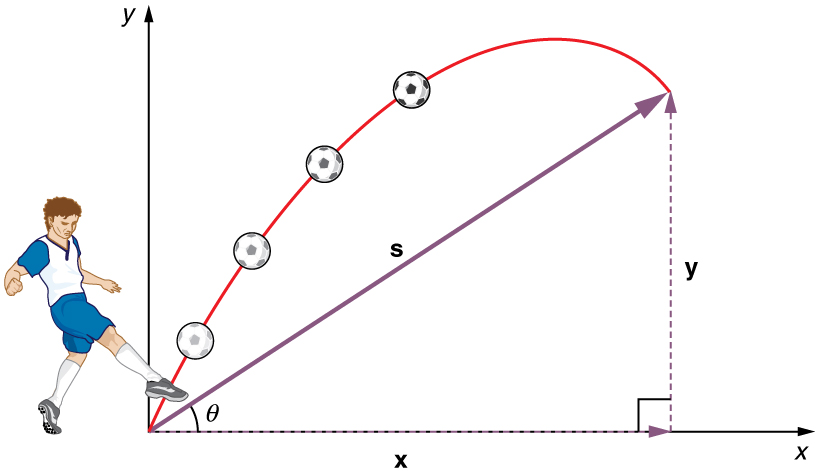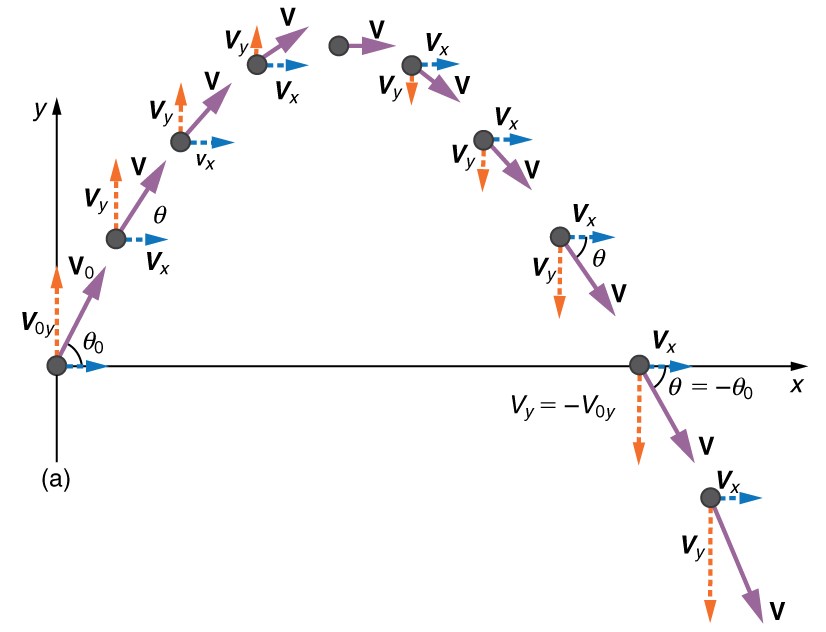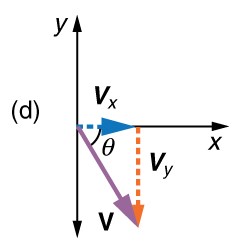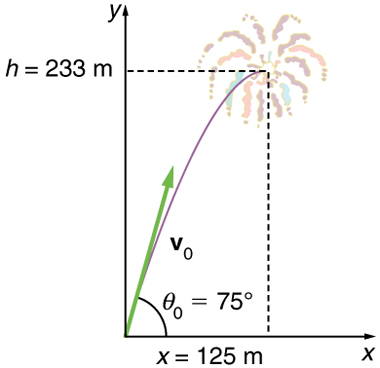[OpenStax College Physics 2e: Two-dimensional kinematics] Two-dimensional motion: Two-dimensional motion
 Projectile motion I
Projectile motion I
Projectile motion is the motion of an object thrown or projected into the air, subject to only the acceleration of gravity. The object is called a projectile, and its path is called its trajectory.
The motion of falling objects, as covered in Falling objects, is a simple one-dimensional type of projectile motion in which there is no horizontal movement. In this page, we consider two-dimensional projectile motion, such as that of a football, and we assume that air resistance is negligible for all objects treated. The most important fact to remember here is that motions along perpendicular axes are independent and, thus, can be analyzed separately. This fact was discussed in Introduction to two-dimensional motion, where vertical and horizontal motions were seen to be independent.
The key to analyzing two-dimensional projectile motion is to break it into two motions, one along the horizontal axis and the other along the vertical. This choice of axes is the most sensible, because acceleration due to gravity is vertical, thus, there will be no acceleration along the horizontal axis when air resistance is negligible. As is customary, we call the horizontal axis the #x#-axis and the vertical axis the #y#-axis.
Figure 1 illustrates the notation for displacement, where #\blue{\blue{\vec{s}}}# is defined to be the total displacement
\[\blue{\vec{s}} = \blue{\vec{s}_0} + \orange{\vec{v}_0}\cdot t + \dfrac{1}{2}\cdot\purple{\vec{a}}\cdot t^2\]
Its components along the horizontal and vertical axes are #\blue{\vec{x}}# and #\blue{\vec{y}}#, respectively. The magnitudes of these vectors are #\blue{\norm{s}}#, #\blue{\norm{x}}#, and #\blue{\norm{y}}#, respectively.

\[\orange{\vec{v}} = \orange{\vec{v}_0} + \purple{\vec{a}}\cdot t\]
We must find their components along the #x#- and #y#-axes, too. We will assume all forces except gravity (such as air resistance and friction, for example) are negligible. The components of acceleration are then very simple: #\purple{a_y}=–\purple{g}=–\purple{\unit{9.81}{m/s^{2}}}#. Note that this definition assumes that the upward direction is defined as the positive direction. If you arrange the coordinate system instead such that the downwards direction is positive, then acceleration due to gravity takes a positive value. Because gravity is vertical, #\purple{a_x}=\purple{0}#.
Analysis of projectile motion
Given these assumptions, the following steps are then used to analyze projectile motion.
Step 1 Resolve or break the motion into horizontal and vertical components along the #x#- and #y#-axes. Since the axes are perpendicular, we use
\[ {A}_{x}=\norm{\vec{A}}\cdot \cos\green{\theta}\quad\text{and}\quad {A}_{y}=\norm{\vec{A}}\cdot \sin\green{\theta} \]
The magnitude of the components of displacement #\blue{\vec{s}}# along these axes is #\blue{\norm{x}}# and #\blue{\norm{y}}#. The magnitudes of the components of the velocity #\orange{\vec{v}}# are #\orange{v_x}=\norm{\orange{\vec{v}}}\cdot\cos\green{\theta} # and #\orange{v_y}=\norm{\orange{\vec{v}}}\cdot\sin\green{\theta}#, where #\norm{\orange{\vec{v}}}# is the magnitude of the velocity and #\green{\theta} # is its direction, as shown in Figure 2. Initial values are denoted with a subscript #0#, as usual.
Step 2 Treat the motion as two independent one-dimensional motions, one horizontal and the other vertical.
The equations of motion for horizontal and vertical motion take the following forms:
Horizontal motion
(#\purple{a_x} = \purple{0}#)
\[ \begin{array}{rcl}\blue{x} &=&\blue{{x}_{0}}+\orange{v_x}\cdot t \\
\orange{v_x}&=&\orange{v_{0x}}\;\,=\;\, \text{velocity is a constant}\end{array}\]
Vertical motion
(Assuming the positive direction is upwards)
\[\begin{array}{rcl}
\purple{a_y}&=&-\purple{g}\;\,=\;\, -\purple{\unit{9.81}{m/s^2}}\\
\blue{y} &=&\blue{{y}_{0}}+\dfrac{1}{2}\cdot (\orange{v_{0y}}+\blue{v_y})\cdot t\\
\orange{v_y}&=&\orange{v_{0y}}-\purple{g}\cdot t\\
\blue{y} &=&\blue{{y}_{0}}+\orange{v_{0y}}\cdot t-\dfrac{1}{2}\cdot {\purple{g}\cdot t}^{2}\\
\orange{v_y}^{2}&=&\orange{v_{0y}}^{2}-2\cdot \purple{g}\cdot (\blue{y}-\blue{{y}_{0}})\end{array}
\]
Step 3 Solve for the unknowns in the two separate motions, one horizontal and one vertical. Note that the only common variable between the motions is the time #t#. The problem-solving procedures here are the same as for one-dimensional motion and are illustrated in the solved examples below.
Step 4 Recombine the two motions to find the total displacement #\blue{\vec{s}}# and velocity #\orange{\vec{v}}#. Because the #x#- and #y#-motions are perpendicular, we determine these vectors by using the techniques outlined in the Vector addition and subtraction: analytical methods and employing both #\norm{A}=\sqrt{{A}_{x}^{2}+{A}_{y}^{2}}# and #\green{\theta} ={\tan}^{-1}({A}_{y}/{A}_{x})# in the following form, where #\green{\theta} # is the direction of the displacement #\blue{\vec{s}}# and #\green{\theta_v}# is the direction of the velocity #\orange{\vec{v}}#
\[ \begin{array}{rcl}
\blue{\norm{\vec{s}}}&=&\sqrt{\blue{x}^{2}+\blue{y}^{2}}\\
\green{\theta} &=&{\tan}^{-1}(\blue{y}/\blue{x})\\
\orange{\norm{\vec{v}}}&=&\sqrt{\orange{v_x}^{2}+\orange{v_y}^{2}}\\
\green{\theta_v}&=&{\tan}^{-1}(\orange{v_y}/\orange{v_x})
\end{array}
\]

![]()


A fireworks projectile explodes high and away
During a fireworks display, a shell is shot into the air with an initial speed of #\orange{\unit{68.07}{m/s}}# at an angle of #\green{61.96^\circ}# above the horizontal, as illustrated in Figure 3. The fuse is timed to ignite the shell just as it reaches its highest point above the ground.
Calculate the height at which the shell explodes.
1. Outline a strategy
Because air resistance is negligible for the unexploded shell, the analysis method outlined above can be used. The motion can be broken into horizontal and vertical motions. In this case, we focus on the vertical motion, in which #\purple{a_y}=–\purple{g}#. We can then define #\blue{y_0}# to be zero and solve for the desired quantity.
2. Solve for the height
By “height” we mean the altitude or vertical position #\blue{y}# above the starting point. The highest point in any trajectory, called the apex, is reached when #\orange{v_y}=\orange{0}#. Since we know the initial and final velocities, as well as the initial position, we use the following equation to find #\blue{y}#
\[ \begin{array}{rcl}
\orange{v_y}^{2}&=&\orange{{v}}_\orange{0y}^2-2\cdot \purple{g}\cdot (\blue{y}-\blue{y_0})\\
&& \quad\blue{\text{time-independent equation of motion}}\\
\orange{0}&=&\orange{{v}}_\orange{0y}^2-2\cdot \purple{g}\cdot \blue{y}\\
&& \quad\blue{\text{replaced } y_0=0\text{ and } v_y = 0}\\
\blue{y}&=&\dfrac{\orange{{v}}_\orange{0y}^2}{2\cdot \purple{g}}\\
&& \quad\blue{\text{solved for }y}
\end{array} \]

Now we must find #\orange{{v}_{0y}}#, the component of the initial velocity in the #y#-direction. It is given by #\orange{{v}_{0y}}=\orange{{v}_{0}}\cdot\sin\green{\theta} #, where #\orange{{v}_{0y}}# is the initial velocity of #\orange{\unit{68.07}{m/s}}#, and #\green{{\theta }_{0}}=\green{61.96^\circ}# is the initial angle
\[ \begin{array}{rcl}\orange{{v}_{0y}}&=&\orange{{v}_{0}}\cdot\sin\green{{\theta }_{0}}\\
&& \quad\blue{y\text{-component of the initial velocity}}\\
&=&\orange{68.07}\cdot \sin (\green{61.96^\circ})\\
&& \quad\blue{\text{filled in numerical values}}\\
&=&\orange{\unit{60.08}{m/s}}\\
&& \quad\blue{\text{computed}}
\end{array}
\]
and #\blue{y}# is
\[ \begin{array}{rcl}
\blue{y}&=&\dfrac{\orange{{v}}_\orange{0y}^2}{2\cdot \purple{g}}\\
&& \quad\blue{\text{expression for }y}\\
&=&\dfrac{(\orange{60.08})^{2}}{2\cdot \purple{9.81} }\\
&& \quad\blue{\text{filled in numerical values}}\\
&=& \blue{\unit{184.0}{m}}\\
&& \quad\blue{\text{computed}}\\
&=& \blue{\unit{184}{m}}\\
&& \quad\blue{\text{expressed the result with three significant digits}}\\
\end{array}\]
Discussion
Because the positive direction is upwards, the initial velocity is positive, as is the maximum height, but the acceleration due to gravity is negative. Moreover, the maximum height depends only on the vertical component of the initial velocity, so that any projectile with a #\orange{\unit{60.08}{m/s}}# initial vertical component of velocity will reach a maximum height of #\blue{\unit{184}{m}}# (neglecting air resistance). The numbers in this example are reasonable for large fireworks displays, the shells of which do reach such heights before exploding. In practice, air resistance is not completely negligible, and so the initial velocity would have to be somewhat larger than that given to reach the same height.

Or visit omptest.org if jou are taking an OMPT exam.



